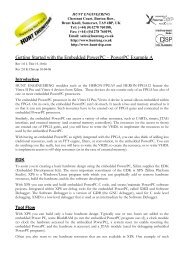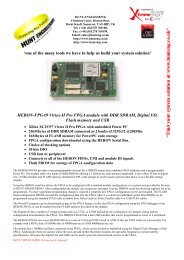FPGA Digital I/Os - Hunt Engineering Ltd.
FPGA Digital I/Os - Hunt Engineering Ltd.
FPGA Digital I/Os - Hunt Engineering Ltd.
Create successful ePaper yourself
Turn your PDF publications into a flip-book with our unique Google optimized e-Paper software.
Some HUNT ENGINEERING <strong>FPGA</strong> modules provide locations for series resistors to be fitted.<br />
These resistors enable 5V signals to be input to the <strong>FPGA</strong>. The series resistors in combination with<br />
input clamp diodes and the over-voltage protection devices limit the <strong>FPGA</strong> input to 3.3V, with the<br />
remaining input voltage being dropped across the series resistor.<br />
The series resistors required for 5V connection must be requested when an <strong>FPGA</strong> module is ordered.<br />
There is no way to provide 5V output signals from the module, but mostly 5V standards will accept the<br />
levels driven from LVTTL which is a 3.3V standard.<br />
Signal Termination<br />
When transmitting and receiving data it is very important to consider signal termination. Depending on<br />
the I/O standard that has been chosen the type and value of the termination will vary.<br />
Properly terminating the <strong>Digital</strong> I/O signals can be done in one of two ways. Firstly, the <strong>FPGA</strong><br />
modules provide locations for resistor packs so that groups of digital I/<strong>Os</strong> can receive series resistors<br />
or parallel termination resistors across a signal pair.<br />
Secondly, with some <strong>FPGA</strong> modules it is possible to use the internal <strong>Digital</strong>ly Controlled Impedance<br />
(DCI) feature of the Xilinx <strong>FPGA</strong>.<br />
Using the Module Resistor Packs<br />
Resistor packs can be fitted to some <strong>FPGA</strong> modules and can perform one of two functions. The first<br />
function is to provide a series resistance between the pin of the <strong>Digital</strong> I/O connector and the <strong>FPGA</strong>.<br />
The second function is to provide a parallel resistor between a pair of <strong>Digital</strong> I/O signals for<br />
terminating a differential connection.<br />
It should be noted at this point that all <strong>FPGA</strong> modules are built as standard with a value of 0 Ohms for<br />
all series termination resistors, and with no parallel resistors fitted.<br />
This means that if a particular termination scheme is required the fitting of resistors, and the values<br />
required must be specified at the time of ordering.<br />
Using <strong>Digital</strong>ly Controlled Impedance (DCI)<br />
Most <strong>FPGA</strong> families allow the use of <strong>Digital</strong>ly Controlled Impedance to control the impedance of<br />
certain I/O pins. For each <strong>FPGA</strong> I/O bank, the <strong>FPGA</strong> uses a pair of external resistors connected to<br />
the VRN and VRP pins of the <strong>FPGA</strong> to define the termination resistance value.<br />
To use DCI the IOSTANDARD attribute must be applied to each I/O instance that requires the use of<br />
digitally controlled impedance. The following VHDL shows an example of how this would be done if a<br />
DCI LVDS buffers were required:<br />
attribute IOSTANDARD : string;<br />
attribute IOSTANDARD of iDIOA0 : label is "LVDCI_33";<br />
To correctly use DCI the right value of external resistance must be connected to the VRN and VRP<br />
pins of the <strong>FPGA</strong>. By default <strong>FPGA</strong> modules are fitted with 50 Ohm resistors to VRN and VRP. This<br />
is the value that is most widely used by the many different DCI I/O standards of Xilinx <strong>FPGA</strong>s. If a<br />
different DCI value is required this must be specified when the module is ordered.<br />
4












